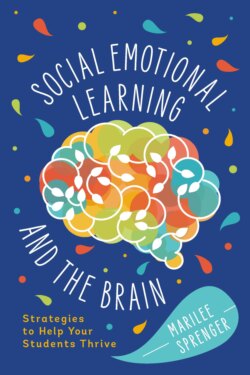Social-Emotional Learning and the Brain

Реклама. ООО «ЛитРес», ИНН: 7719571260.
Оглавление
Marilee Sprenger B.. Social-Emotional Learning and the Brain
Social-Emotional Learning and the Brain
Table of Contents
ASCD Member Book / Also by the Author
Also by the Author
Dedication
Acknowledgments
Introduction
Brain Structures and Chemicals Related to SEL
Don't Let Emotion Drive the Bus!
Storytelling in the Brain
Chapter Overview
Chapter 1: Building Teacher-Student Relationships
Chapter 2: Empathy
Chapter 3: Self-Awareness
Chapter 4: Self-Management
Chapter 5: Social Awareness
Chapter 6: Relationship Skills
Chapter 7: Responsible Decision Making
Chapter 8: People, Not Programs: The Positive Impact of SEL
Building Teacher-Student Relationships
Maslow Before Bloom
Relationships in the Brain
Figure 1.1. Relationships in the Brain
Strategies for Building Teacher-Student Relationships
Display Vulnerability
Greet Students at the Door
You Say Hello; You Say Goodbye
Tell Your Story
Use Five Ways to Show You Care
Write Notes to Students
Stick It to Them
Be a Name-Caller
Call on Each Student Regularly
Go the Extra Mile
Try 2 × 10
Assign Seats
Schedule Advisories
Conduct Morning Meetings
Form a Lunch Bunch
Nurture Relationships
Every Student Has a Story
Empathy
I Feel Your Pain
Types of Empathy
Empathy in the Brain
Figure 2.1. Empathy in the Brain
Strategies for Developing Empathy
Modeling
Seeking to Understand
"Ask, Don't Tell"
Notes of Appreciation
A Kindness Wall
Face-to-Face Conversations
Community Service Projects
Volunteer Work
Classroom Pets
Mix-It-Up-at-Lunch Day
Literature
Epiphany in a Brown Paper Bag
Crumpled Hearts
Teacher Self-Assessment
Every Student Has a Story
Self-Awareness
Self-Awareness in the Brain
Figure 3.1. Self-Awareness in the Brain
Strategies for Teaching Self-Awareness
An Emotion Vocabulary
Figure 3.2. Example of an Emotion Word Wall
Greetings
An Emotional Inventory: Check-Ins
Journaling
Drawing
Taking a Break
"I Wish My Teacher Knew …"
Self-Perception "Boots"
Listening to the Body
Identifying Strengths and Weaknesses
Self-Confidence Builders
Developing Self-Efficacy
Every Student Has a Story
Self-Management
Self-Management in the Brain
Figure 4.1. Self-Management in the Brain
Strategies for Teaching Impulse Control
Breathing Exercises
The Feeling Thermometer
Strategies for Teaching Stress Management
Predictability: Routines, Structures, Rituals, and Procedures
The 90-Second Rule
Tone of Voice
Therapy Dogs
Mindfulness
Figure 4.2. 4 × 4 Breathing
Calming Station
Emotion Planner
Figure 4.3. Emotion Planner
Strategies for Teaching Self-Discipline
Party-Planning Experience
Brain Break
Strategies for Teaching Self-Motivation
Success Circle
Makerspaces
Strategies for Teaching Goal Setting and Organizational Skills
Every Student Has a Story
Social Awareness
Social Awareness in the Brain
Figure 5.1. Social Awareness in the Brain
Prosocial Skills and Norms
Social Pain: Is It Real?
Emotional Contagion
The Role of Empathy
Strategies to Increase Social Awareness
Giving as a Way of Receiving
Talking Pencils
Think-and-Feel-Alouds
The Many Roles We Have
Greeting Fellow Students by Name
Body Language: Gestures and Other Body Movements
People Watching: Facial Expressions
Social Media
Listening to Understand and Show Respect
Think, Pair, Share
Discussion Tasks
Learning Targets and Social Awareness
Every Student Has a Story
Relationship Skills
Relationships in the Brain
Figure 6.1. Handling Relationships in the Brain
Strategies to Promote Collaboration
Teaming
Figure 6.2. Sample Team Chart
Project-Based Learning (PBL)
Cooperative Learning
Jigsaw
Strategies for Communication
No Phone, New Friends Friday
Journaling After Cooperative Learning or Teamwork
Role Playing
Strategies for Relationship Building
Brainstorming
Classroom "Seating Challenges"
Assigned Seating at Lunch
Restorative Practices and Peacemaking Circles
Every Student Has a Story
Responsible Decision Making
SEL and Responsible Decision Making
Decision Making in the Brain
Figure 7.1. Decision Making in the Brain
Factors in Decision Making: Time, Values, and Priorities
Time
Values and Priorities
Keeping Mindfulness in Mind
Strategies for Decision Making
Guts Versus Heads
Five-Part Decision Making: The Birthday Party Dilemma
Offering Choice Through Classroom Jobs
Debate
Constructive Controversy
Magic 8-Ball
Dear Abby
Conver-stations
Phone a Friend
Ask Your Audience
A General Guide to Decision Making in Your Class
Every Student Has a Story
People, Not Programs: The Positive Impact of SEL
Student Regulation Begins with Adult Regulation
Three Terms to Know
How Emotions Affect Decision Making
From ACEs to PACEs
Getting to Know Every Child
Every Student Has a Story—and Every Educator Has a Responsibility
Glossary
References
Study Guide
Introduction
Chapter 1. Building Teacher-Student Relationships
Chapter 2. Empathy
Chapter 3. Self-Awareness
Chapter 4. Self-Management
Chapter 5. Social Awareness
Chapter 6. Relationship Skills
Chapter 7. Responsible Decision Making
Chapter 8. People, Not Programs: The Positive Impact of SEL
Related ASCD Resources
Print Products
DVDs
PD Online
ASCD myTeachSource®
Whole Child
Whole Child Tenets
About the Author
Отрывок из книги
Strategies to Help Your Students Thrive
Marilee Sprenger
.....
Keep envelopes with each student's name in your desk and occasionally write notes to students. Let students know what you appreciate about them or how you liked some of their work. You might keep the envelopes in a file, and after you give a student a letter, put that student's envelope at the back of the bunch. This way you can be certain to reach out to every student.
In a variation of the note-writing strategy, keep a stack of sticky notes handy, and whenever a student does something that you want to point out, write it on a sticky note and put the note on the student's desk, locker, or notebook. The note can be anything from "You played a great game last night!" to "I saw you helping the new student, and I'm sure he appreciated it!"
.....